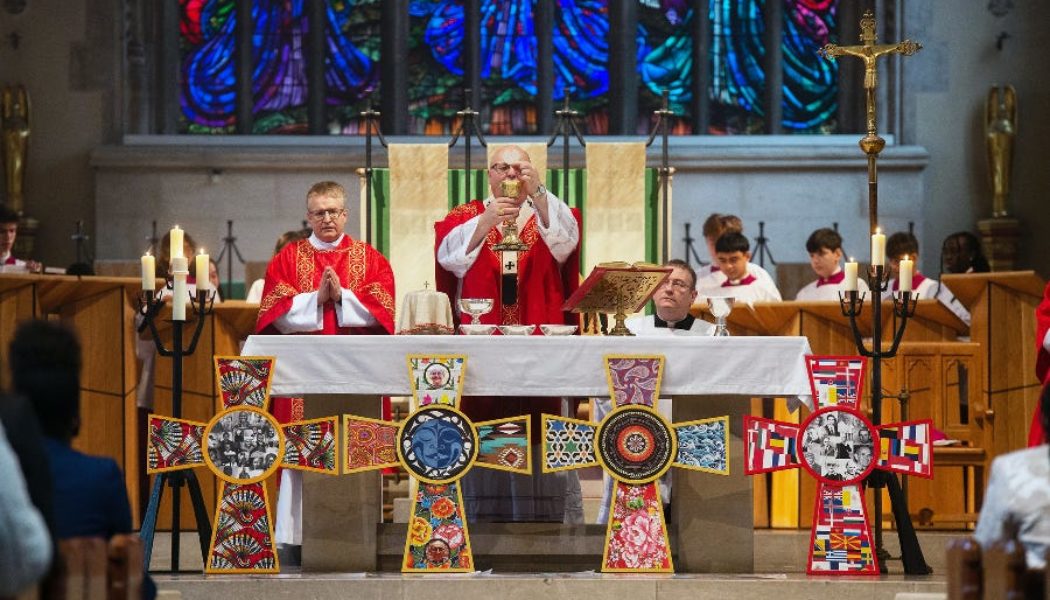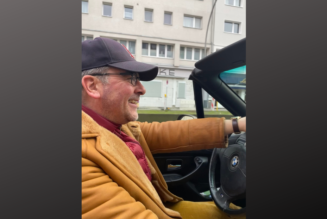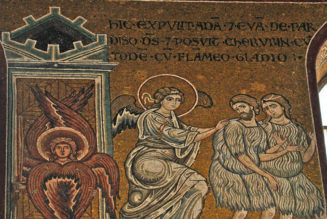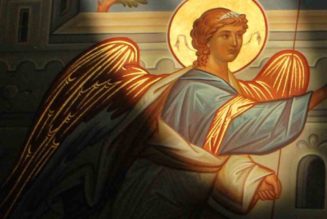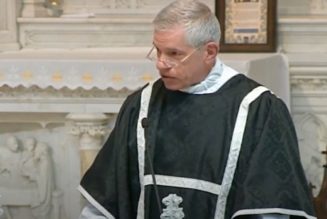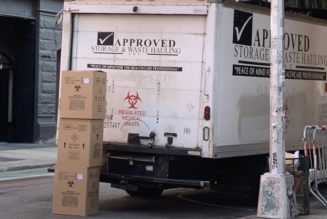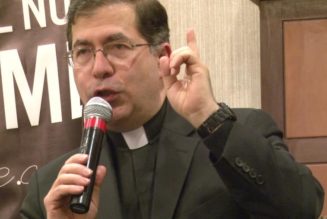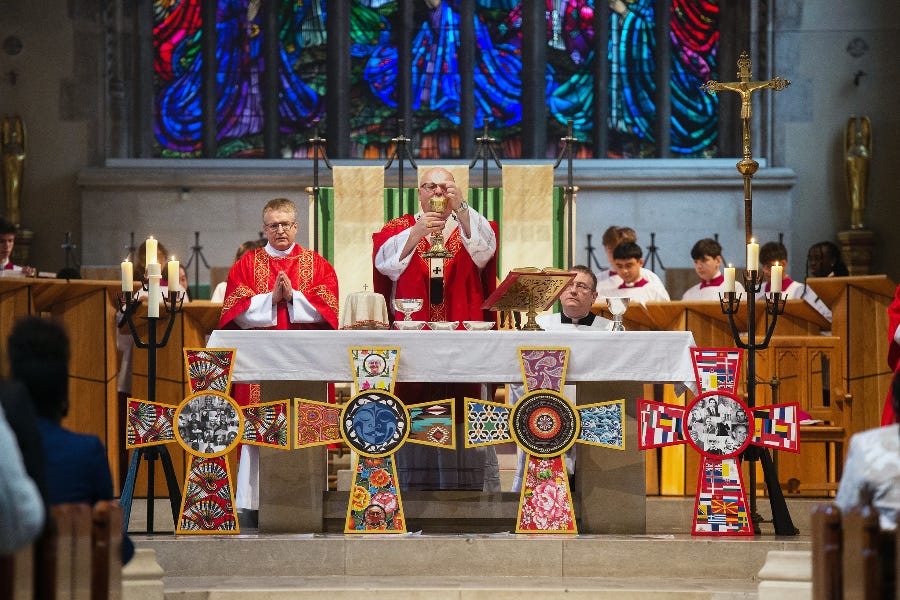
Pope Francis urged Catholics in Rome diocese last September to make sure that as many people as possible took part in the opening stage of the two-year global synodal process.
“Wouldn’t it look bad if the pope’s own diocese was not committed to this?” Francis asked. “Yes, it would look bad, for the pope, but also for you!”
Later in his address, the pope mentioned a specific percentage of Catholics that he wanted consultations to reach beyond.
“Don’t limit yourself to those who come to church or think as you do – they may be no more than 3, 4, or 5 percent,” he said. “Let everyone come in… Go out and meet them, let them question you, let their questions become your questions. Journey together: the Spirit will lead you; trust in the Spirit.”
Pope Francis returned to this idea at the end of his long speech, saying that the Church needed “to pass beyond the 3 or 4 percent that are closest to us, to broaden our range and to listen to others.”
Perhaps the pope didn’t intend his reference to percentages to be taken literally. He may simply have been encouraging organizers to reach out beyond the “usual suspects” in the consultation phase.
Nevertheless, his remarks could offer some kind of baseline by which to judge participation rates in an initiative described as the largest consultation of Catholics ever undertaken.
Currently, information about participation in the diocesan phase is patchy. While several countries have published a “national synthesis” document giving participant estimates, many bishops’ conferences are still finalizing their reports ahead of the Vatican’s Aug. 15 deadline for submissions.
Most of the participation figures mentioned in the reports are approximations, given that in most cases scores of separate consultations took place, both in person and online, with varying amounts of record-keeping. Participants included not only parishioners, but also non-Catholics and members of marginalized groups such as abuse survivors, the homeless, and prisoners.
Some reports show meticulous attention to participation in events, while others remain vague or present figures in a fragmentary way. The synthesis document of the Diocese of Rome, for example, says only: “In almost all Roman parishes consultation and listening activities have been initiated. Over 40% of these sent their contribution for the drafting of the diocesan synthesis within the established deadlines.”
Consultation organizers would doubtless note that they were working to a tight deadline on an unprecedented global project at the tail end of a pandemic that severely affected church attendance and complicated the workings of small groups.
Several reports expressed frustration at limited participation. The Diocese of Hamilton in New Zealand, for example, said: “When considering the process as a whole, the principal theme that occurred to the committee was that of apathy. Marked by the lack of participation in contrast to the marketing and communication efforts.”
Comparing the recorded number of participants to the total number of baptized Catholics in a given area is fraught, because both figures are essentially guesstimates. The calculations below are therefore by no means definitive.
With these caveats, here are some of the figures presently available worldwide, followed by back-of-the-envelope calculations about participation rates:
The Archdiocese of Brisbane said that “the process of listening and discernment took place engaging a total of 370 people in the process leading to 145 unique submissions (compared with 17,373 people involved in 2,269 submissions for the Plenary Council).”
It explained that, before the pandemic, “there were a little less than 60,000 regular parishioners although over 700,000 people continued to identify as Catholic in the national census.” But since the pandemic, “the archdiocese has seen a decline in Mass attendance of around 34%.”
Calculation:
Participants: 370
Total Mass-going Catholics: 39,600
Participation: 0.93%Participants: 370
Total baptized Catholics: 700,000
Participation: 0.05%
The Archdiocese of Melbourne reported that “86 individuals made submissions, and 53 groups made submissions, representing over 500 people.” It explained that “some group submissions did not provide the details of the number of participants, and it is likely the number of those represented is higher.”
The synthesis said that the archdiocese served more than 1,000,000 Catholics, “with approximately 77,000 attending Sunday Mass on a regular basis.”
Calculation:
Participants: 500+
Total Mass-going Catholics: 77,000
Participation: >0.65%Participants: 500+
Total baptized Catholics: 1,000,000
Participation: >0.05%
The Diocese of Parramatta said: “In the consultation and discernment process, we have welcomed the contributions from at least 650 people from within the region, either in group or individual submissions.”
It noted that “in the most recently published Australian Census (2016), approximately 323,000 people nominated as Catholic in the area designated as the Diocese of Parramatta.” It added that “the most recent Mass attendance figures indicated 14.6% of Catholics attended Mass during the four-week survey period,” or roughly 47,000 people.
Calculation:
Participants: 650
Total Mass-going Catholics: 47,000
Participation: 1.38%Participants: 650
Total baptized Catholics: 323,000
Participation: 0.2%
The Archdiocese of Perth’s report said: “Overall, the total number of respondents from the Archdiocese of Perth was 12,624.”
There are a total of 429,715 Catholics in the archdiocese.
Calculation:
Participants: 12,624
Total baptized Catholics: 429,715
Participation: 2.94%
Belgium’s national synthesis document said that the number of participants in the diocesan synodal process varied “in each diocese between 2,000 and 4,000.” There are eight dioceses in Belgium.
The report also mentioned that “one diocese focused its synodal process primarily on youth and surveyed 10,000 young people,” without offering a total participation figure.
Erring on the side of generosity, let’s assume that one diocese had 2,000 participants, six had 4,000, and one had 10,000, for a total of 36,000.
How many Catholics are there in Belgium?
An estimated 57% of the Belgian population identifies as Catholic. The website Worldometer says that Belgium’s total population is 11,694,719, so there are roughly 6,700,000 Catholics.
A total Mass attendance of 241,029 people was recorded in October 2019.
Calculation:
Participants: 36,000
Total Mass-going Catholics: 241,029
Participation: 14.94%Participants: 36,000
Total baptized Catholics: 6,700,000
Participation: 0.54%
Organizers said that “approximately 15,000 people” took part in the synodal process during the diocesan phase from November 2021 to February 2022.
How many Catholics are there in the Czech Republic?
The 2021 census said there were 741,000 Catholics in the country.
Calculation:
Participants: 15,000
Total baptized Catholics: 741,000
Participation: 2.02%
The national synthesis document of the Catholic Church in England and Wales, released on June 22, said that participation varied widely in parishes from 34% to 93%.
“Levels of participation were not always noted. Dioceses that reported numbers did so often in terms of the percentage of institutions taking part,” it said.
It continued: “At the time the listening process began in autumn 2021, when public worship was still subject to government restrictions and the nation grappled with a new strain of coronavirus, the bishops’ conference recorded a Mass-going population in England and Wales of just 370,000. Extrapolating from the reports that under 10 percent of that population took part in some way in the synod, we estimate that around 30,000 people in total took part.”
How many Catholics are there in England and Wales?
“An estimated 3.8 million English and Welsh adults identify as Catholic,” according to the 2016 study “Contemporary Catholicism in England and Wales: A statistical report based on recent British Social Attitudes survey data,” by Stephen Bullivant.
Calculation:
Participants: 30,000
Mass-going Catholics: 370,000
Participation: 8.11%Participants: 30,000
Total baptized Catholics: 3,800,000
Participation: 0.79%
The French bishops’ conference said: “In France, more than 150,000 people have mobilized to contribute to the reflection on the 2023 synod on synodality, by meeting at various levels: dioceses, parishes, movements, spontaneously formed groups, religious congregations.”
How many Catholics are there in France?
According to 2021 data from Ifop, 6.6% of French people say they are practicing Catholics. Worldometer indicates that the French population is 65,572,972. Therefore, there are roughly 4,328,000 Mass-going Catholics.
How many baptized Catholics are there? “According to an Ifop study, about 65% of French people declared themselves to be Catholics in 2010 (i.e. more than 40 million),” reported AFP in 2016.
Calculation:
Participants: 150,000
Mass-going Catholics: 4,328,000
Participation: 3.47%Participants: 150,000
Total baptized Catholics: 42,600,000
Participation: 0.35%
The Archdiocese of Dublin said in its report: “A total of 173 parishes hosted gatherings for 10,500 participants. These gatherings were coordinated by 325 animators who took part in two online training sessions and additional support sessions. The average gathering had between 35 and 40 participants, however the largest gathering had 280 participants. Another 2,200 people participated in other ways, mainly in focus groups.”
Calculation:
Participants: 12,700
Total baptized Catholics: 1,121,200
Participation: 1.13%
The Diocese of Limerick reported that “more than 4,000 people responded to questionnaires and a further 1,500 people participated in large gatherings and small group discussions.”
It added that it served a Catholic population of approximately 155,000 people.
Calculation:
Participants: 5,500
Total baptized Catholics: 155,000
Participation: 3.55%
The Archdiocese of Luxembourg said that 4,590 people took part in the synod’s diocesan phase.
How many Catholics are there in Luxembourg?
According to Wikipedia, there are 439,280.
Calculation:
Participants: 4,590
Total baptized Catholics: 439,280
Participation: 1.04%
The Archdiocese of Wellington’s report said that organizers “received 237 group submissions and 395 individual submissions, engaging over 1,500 people.”
The report noted that the archdiocese had “an average pre-pandemic Sunday Mass count of 11,000.” In 2020, there were an estimated 81,700 total Catholics in the archdiocese.
Calculation:
Participants: 1,500
Mass-going Catholics: 11,000
Participation: 13.64%Participants: 1,500
Total baptized Catholics: 81,700
Participation: 1.84%
The Diocese of Palmerston North said: “Due to the nature of the various ways in which people participated in the process, it is not clear exactly how many people have been involved. However, from a total of approximately 230 submissions received, it appears that around 500 people have taken part in the consultation phase in some way.”
The diocese reported a total of 51,345 affiliated Catholics in the diocese, with 7,255 Sunday Mass-goers.
Calculation:
Participants: 500
Mass-going Catholics: 7,255
Participation: 6.89%Participants: 500
Total baptized Catholics: 51,345
Participation: 0.97%
The report of the Diocese of Kalisz said that “at the diocesan level, about 0.2% of the population participated in the synod.”
The Diocese of Łomża did not give a participation figure, but said: “Pandemic problems caused a decline in interest in the synod. Synodal work was also not served by the diocesan bishop’s indications of pandemic restrictions, among them a ban on small group meetings. Attempts were made to move the work to the internet. However, not everyone felt comfortable in the online space. It should be added that a large group of parishes did not undertake synodal work at all. At the same time, it was noticed that communication within the parish left a lot to be desired. Often pastors did not provide the laity with the necessary information in time.”
The Archdiocese of Poznań reported that “8,610 people participated in the first stage of the Synod on Synodality.”
The archdiocese served a total of 1,477,000 Catholics in 2019.
Calculation:
Participants: 8,610
Total baptized Catholics: 1,477,000
Participation: 0.58%
The Diocese of Świdnica said in its synthesis: “In total, about 1,500 people participated in the synodal work, which is about 3 per mille [per thousand] of the diocese’s population and 1% of practitioners (dominicantes [Sunday Mass-goers]).”
The Diocese of Aberdeen’s synthesis document said that at first there was “some real difficulty in motivating people to participate.”
“Coming out of the Covid-19 pandemic, people have been hesitant to engage in lots of things and the Synod was among them,” it explained. “Objectively speaking, only a small portion of the Catholics in the diocese participated. Nevertheless, many of those who did take part in synodal gatherings were grateful for the opportunity to meet and discuss matters openly.”
The Diocese of Galloway’s report said: “It is difficult to put a number on the individual people who participated in the first phase of the diocesan Synod. The methodology of the parish encounters meant individual post-it notes were collected per question; not everyone answered every question and not every parish attempted every question. In addition, numerous people followed up attendance at an encounter with emailed further thoughts. As a conservative estimate, between five and six hundred people have actively participated, perhaps more.”
It also said that there were a total of 41,353 Catholics in the diocese.
Calculation:
Participants: 600
Total baptized Catholics: 41,353
Participation: 1.45%
The national synthesis document of the Spanish Catholic Church said: “In this shared path, 14,000 synodal groups have participated in Spain, involving more than 215,000 people, most of them lay people, also consecrated persons, religious, priests, and bishops.”
How many Catholics are there in Spain?
“In March 2021, 59.8% of the Spanish population defined themselves as Catholic, according to data from the Centro de Investigaciones Sociológicas (CIS),” said a report in March this year. Spain has a population of 46,792,165, according to Worldometer. Therefore, there are roughly 28,000,000 Catholics in the country.
How many of these are practicing? The CIS found that 10.6% of Catholics say they go to Mass every Sunday, or approximately 3,000,000.
Calculation:
Participants: 215,000
Mass-going Catholics: 3,000,000
Participation: 7.17%Participants: 215,000
Total baptized Catholics: 28,000,000
Participation: 0.77%
The Diocese of St. Gallen’s report underlined “that the 1,090 people from the SG diocese who participated in the survey in 146 groups and completed the online questionnaire represent only a small part of Catholics in the diocese of St. Gallen.”
In 2020, there were 254,900 Catholics in the diocese in northeastern Switzerland.
Calculation:
Participants: 1,090
Total baptized Catholics: 254,900
Participation: 0.43%
The Diocese of Arlington, Virginia, did not offer a total participation figure in its report, but noted that it conducted a total of 145 in-person listening sessions. “People from all walks of life participated prayerfully and wholeheartedly in many synodal listening sessions,” it said.
The Diocese of Covington, Kentucky, reported in its diocesan synthesis that approximately 4,375 people were involved out of 89,035 Catholics.
Calculation:
Participants: 4,375
Total baptized Catholics: 89,035
Participation: 4.91%
The Diocese of Fort Worth, Texas, noted: “There were a total of 112 listening sessions held across the diocese in English, Spanish, Vietnamese and ASL (American Sign Language). The total number of participants was 3,311 of which 41 were individuals who made use of the individual survey link.”
Calculation:
Participants: 3,311
Total baptized Catholics: 1,200,000
Participation: 0.28%
The Diocese of Knoxville, Tennessee, said that “the level of participation in the diocesan synod process was lower than what we expected and hoped for despite the strong advertising, marketing, preaching and parish/school encouragement.”
It added: “The Diocese of Knoxville territory has a Catholic population of 68,000 (this does not include the large number of undocumented Hispanics). Only 4,693 Catholics (approximately 13% of the diocese’s Catholic population) completed the online survey. A significantly lower number participated in the listening sessions.”
The Archdiocese of Louisville, Kentucky, reported a total of 2,389 participants in synod listening sessions.
The archdiocesee serves around 200,000 Catholics.
Calculation:
Participants: 2,389
Total baptized Catholics: 200,000
Participation: 1.19%
The Diocese of St. Petersburg, Florida, said: “Deaneries, parishes and other ministries hosted approximately 156 Synod sessions with approximately 6,480 participants, in multiple languages. Furthermore, the Diocese received over a dozen letters from individual Catholics and approximately 207 responses to the online survey.”
Calculation:
Participants: 6,700
Total baptized Catholics: 500,000
Participation: 1.34%
The Archdiocese of Seattle said that “in all, synod coordinators hosted close to 1,000 gatherings, both online and in person, in which over 11,000 people participated. For those unable to attend, an online survey was provided, drawing over 250 responses.”
Calculation:
Participants: 11,250
Total baptized Catholics: 600,605
Participation: 1.87%
The Archdiocese of Washington, which serves around 655,000 Catholics, did not give an overall participation figure. It noted in its report that 106 of its 139 parishes submitted listening session summaries. It said: “Also submitted were reports from two Catholic High Schools, one independent ecclesial community, The Catholic University of America, one ecumenical synod session, and one verbal report from groups with members who identify as LGBTQ+ Catholics and those who minister to them in the diocese. Additionally, we received over 1,000 individual responses to a survey that was open to all clergy, religious and laity.”
In Venezuela, “about 4,000 meetings were held throughout the country from local Churches to diocesan instances, with the participation of approximately 55,000 people,” reported Diario Católico.
How many Catholics are there in Venezuela?
Around 67% of the 28.2 million people in the country are Catholics, according to 2017 figures.
Calculation:
Participants: 55,000
Total baptized Catholics: 18,890,000
Participation: 0.29%
Editor’s note: This analysis originally miscalculated the population figures for Venezuela, we’ve corrected the numbers. Sorry about that.
Join Our Telegram Group : Salvation & Prosperity
